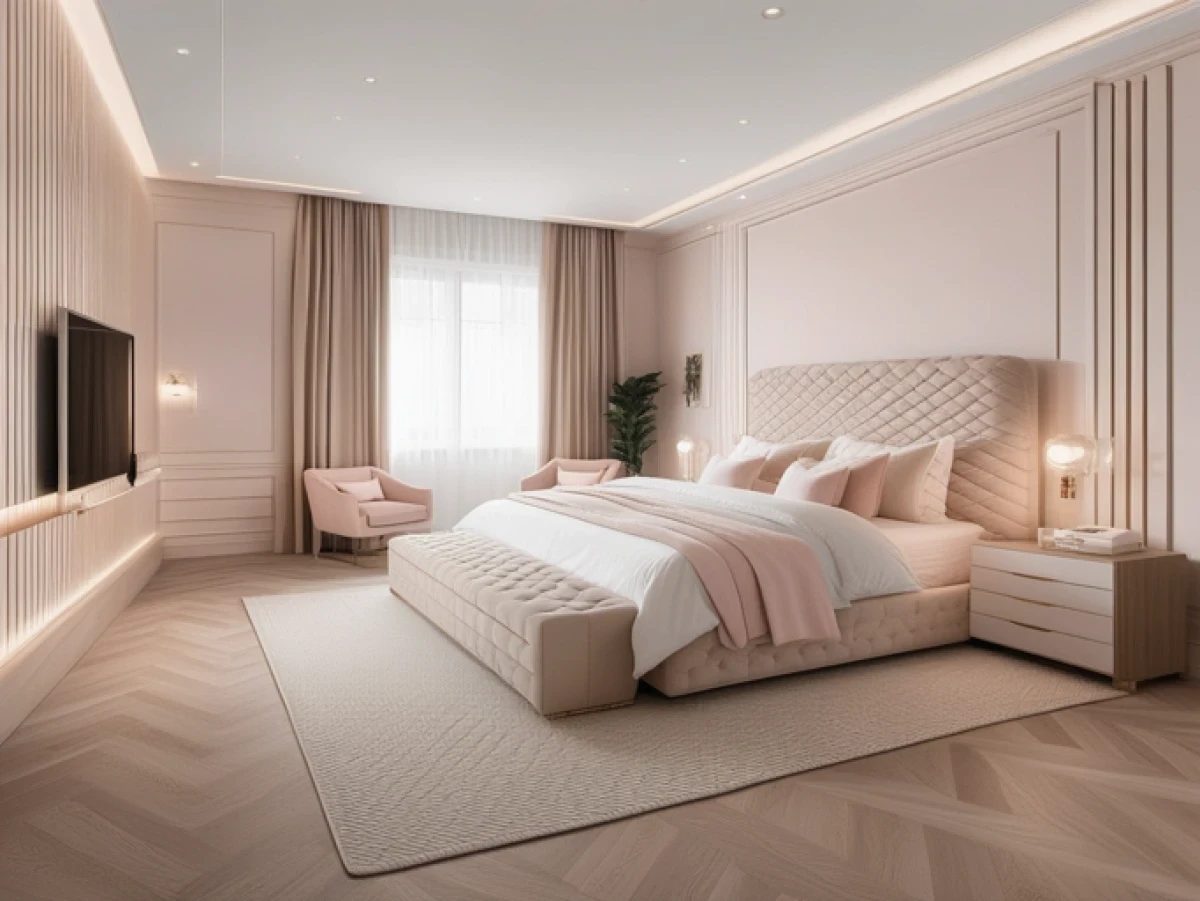The bedroom, our personal sanctuary, has evolved significantly in recent years, transcending its traditional role as merely a place for rest.
In today’s fast-paced world, modern bedroom design embraces both aesthetics and functionality, creating spaces that reflect our individual personalities while promoting tranquility and rejuvenation.
As we navigate through the labyrinth of contemporary design possibilities, the amalgamation of minimalist principles, innovative materials, and cutting-edge technology has redefined what we consider modern.
This comprehensive guide explores 18 sophisticated modern bedroom ideas that cater to various tastes and spatial constraints. Whether you’re planning a complete renovation or seeking subtle updates to refresh your space, these carefully curated ideas will help you create a bedroom that’s both visually striking and supremely comfortable.
Modern Bedroom Ideas
From bold architectural elements to subtle textural interplays, each concept has been selected to inspire and guide you toward achieving your ideal modern bedroom sanctuary.
1. Minimalist Platform Beds
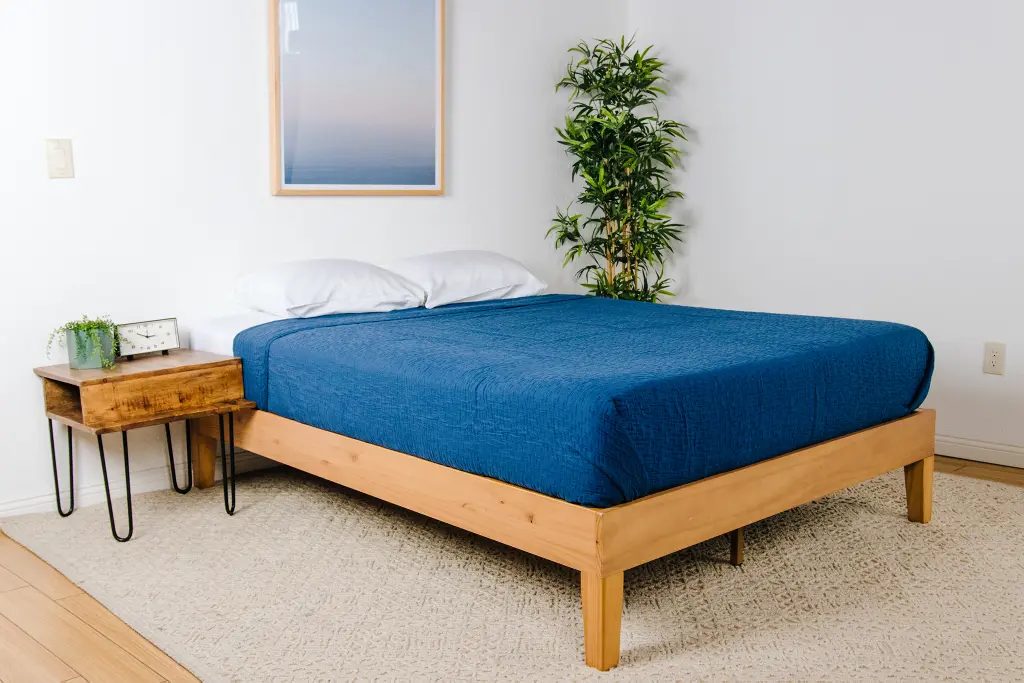
A minimalist platform bed serves as the cornerstone of modern bedroom design. These low-profile beds, characterized by their clean lines and absence of ornate headboards, create an immediate sense of spaciousness and contemporary appeal. The streamlined design typically features a solid base that eliminates the need for a box spring, offering both aesthetic and practical benefits.
The beauty of platform beds lies in their versatility and ability to complement various design schemes. Whether paired with natural wood finishes for a warm, organic feel or sleek metallic accents for an industrial edge, these beds provide a strong foundation for building your modern bedroom aesthetic. The raised platform design often includes hidden storage compartments, making it an excellent choice for urban dwellings where space optimization is crucial.
2. Statement Lighting Fixtures
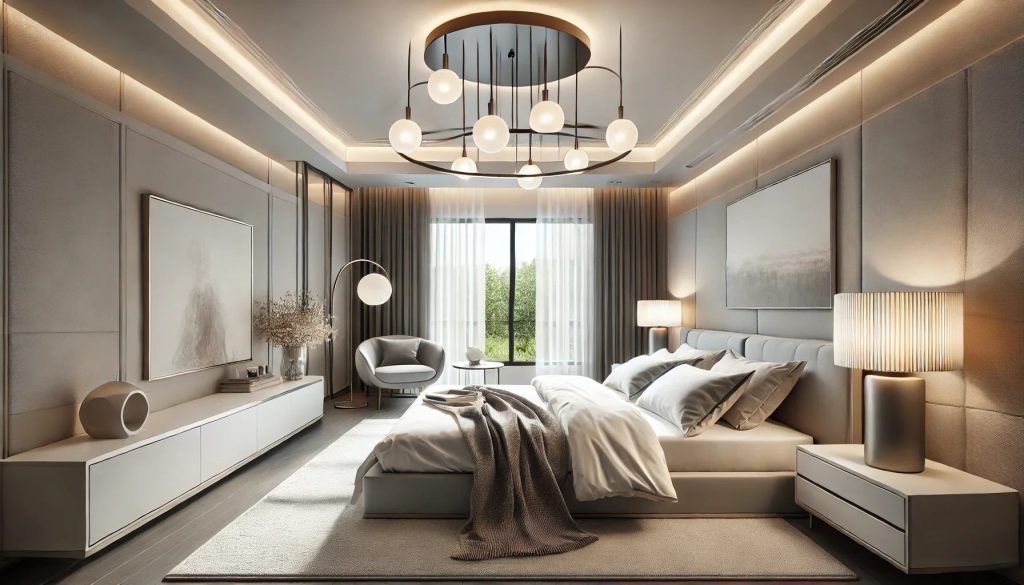
Modern bedroom lighting has transcended basic functionality to become an integral element of room design. Oversized pendant lights, geometric chandeliers, and architectural wall sconces serve as dramatic focal points while providing layered illumination. These fixtures often incorporate materials like brushed metals, glass, and innovative LED technology to create stunning visual effects.
The strategic placement of statement lighting can transform the entire mood of a bedroom. Consider installing dimmable fixtures that can transition from bright, energizing light for daytime activities to soft, ambient illumination for evening relaxation. Wall-mounted reading lights with adjustable arms offer both practicality and sculptural interest, while LED strip lighting behind headboards or under floating furniture creates an ethereal floating effect.
3. Monochromatic Color Schemes
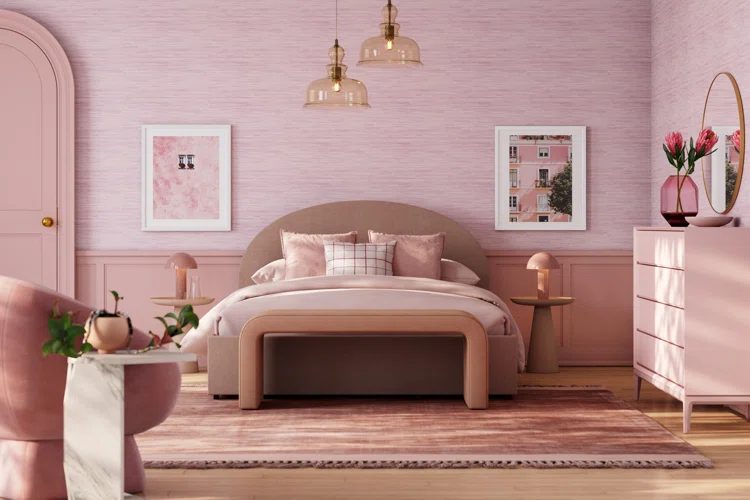
The power of a monochromatic color palette lies in its ability to create a sophisticated, cohesive look while maintaining visual interest through textural variations. Working with different shades and tones of a single color, from deep charcoal to soft gray or varying intensities of warm beige, can produce a serene and unified space that exemplifies modern design principles.
To prevent monotony in a monochromatic scheme, incorporate various textures and materials that reflect light differently. Matte wall finishes can contrast with glossy furniture surfaces, while textured textiles add depth and dimension. This approach creates a layered, nuanced environment that feels both contemporary and inviting without relying on multiple colors to create visual interest.
4. Smart Storage Solutions
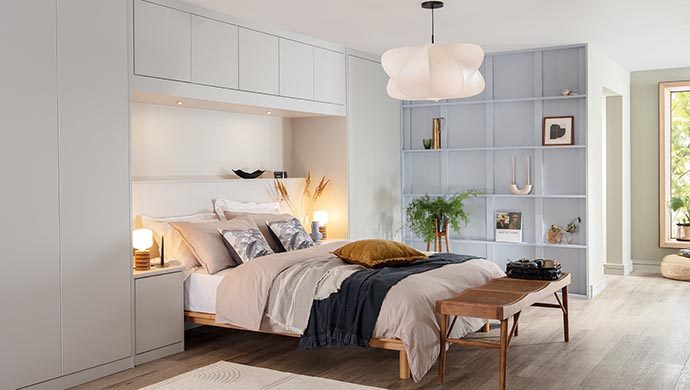
Modern bedroom design emphasizes clever storage solutions that maintain clean lines while maximizing space efficiency. Built-in wardrobes that stretch from floor to ceiling, hidden drawer systems, and multifunctional furniture pieces help eliminate clutter while preserving the room’s aesthetic integrity. These storage solutions often feature touch-latch mechanisms or minimal hardware to maintain a seamless appearance.
Custom storage solutions can be designed to complement the room’s architecture, creating a cohesive look while addressing specific storage needs. Consider incorporating floating shelves, hidden shoe storage, or rotating closet systems that make efficient use of corner spaces. The key is to integrate storage seamlessly into the overall design, ensuring it enhances rather than detracts from the room’s modern appeal.
5. Biophilic Elements
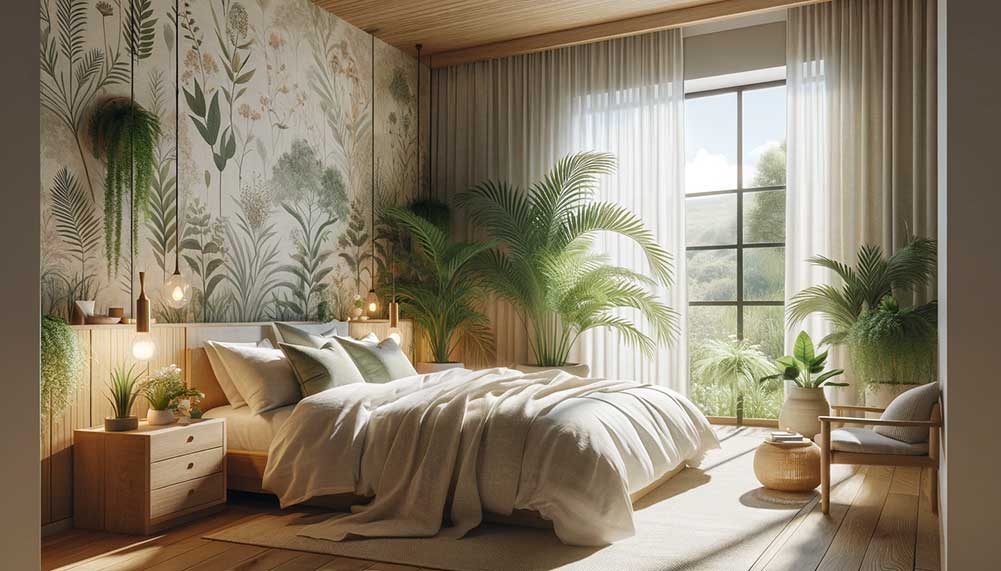
Incorporating natural elements into modern bedroom design creates a connection with nature while maintaining contemporary sophistication. Large windows that frame outdoor views, living walls covered in vertical gardens, and strategically placed indoor plants bring life and energy to the space. This approach to design has been proven to reduce stress and improve sleep quality.
The integration of natural materials such as bamboo, cork, or reclaimed wood adds warmth and texture to modern spaces without compromising their contemporary feel. Consider using these materials in furniture pieces, wall treatments, or decorative elements. Complement these organic elements with natural fabrics and materials in bedding and window treatments to create a harmonious blend of nature and modern design.
6. Floating Furniture
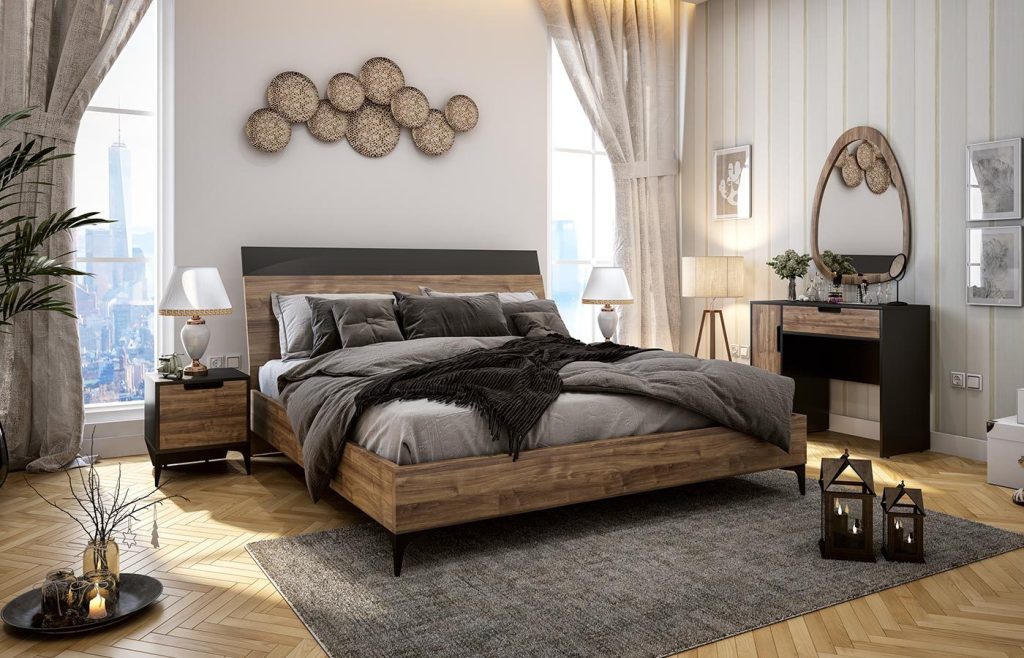
Floating furniture pieces create an illusion of space and lightness in modern bedrooms. Wall-mounted nightstands, suspended dressers, and floating vanities contribute to a clean, uncluttered floor space while adding architectural interest. This design approach is particularly effective in smaller bedrooms where maintaining visual flow is crucial.
The space beneath floating furniture can be utilized for additional storage or left empty to enhance the room’s spacious feel. LED strip lighting installed under floating pieces creates dramatic shadows and adds to the contemporary ambiance. When selecting floating furniture, consider pieces with hidden mounting hardware to maintain the sleek, minimalist aesthetic.
7. Textural Accent Walls
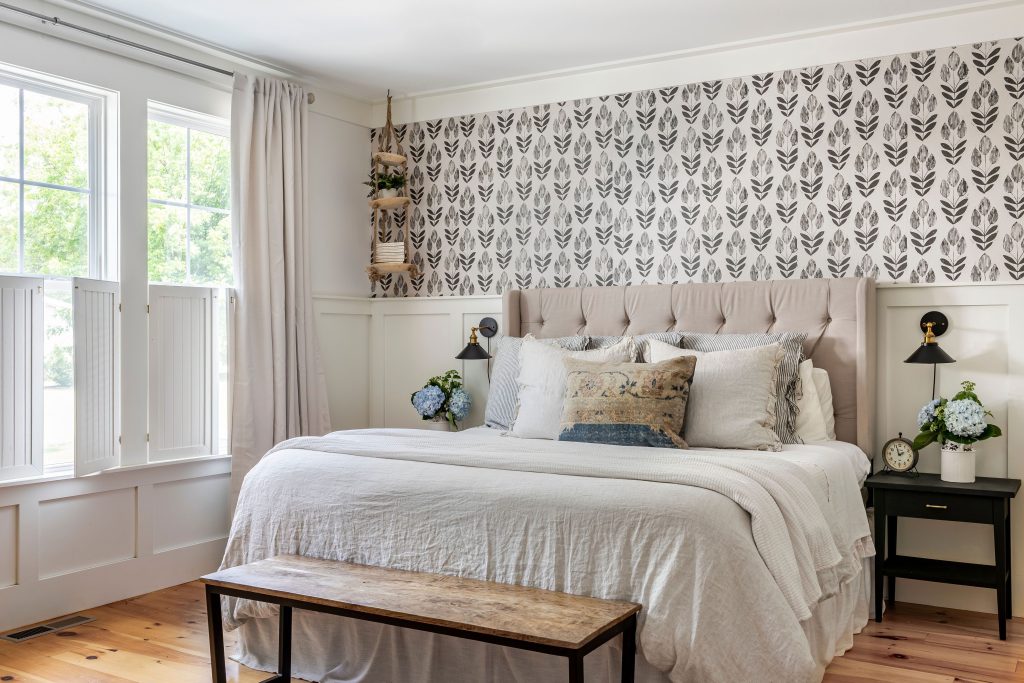
Modern bedroom design often features accent walls that add depth and interest through texture rather than color. Three-dimensional wall panels, custom millwork, or textured wallcoverings create striking focal points while maintaining a sophisticated aesthetic. These elements can range from subtle geometric patterns to bold, sculptural designs that make a dramatic statement.
The key to successful textural accent walls lies in balancing their impact with other room elements. When incorporating a highly textured wall, keep surrounding surfaces and furnishings simple to avoid visual overwhelm. Consider how natural and artificial light will interact with the texture throughout the day to create changing shadows and highlights.
Related Guide: 16 Inspiring Brown Bedroom Ideas
8. Geometric Patterns and Shapes
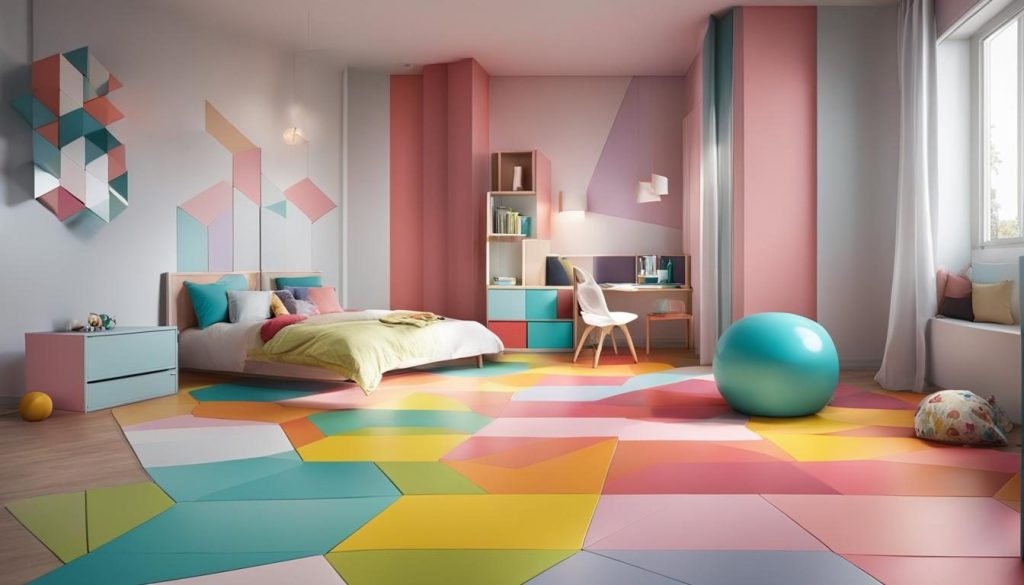
Geometric patterns have become a hallmark of modern bedroom design, offering a sophisticated way to introduce visual interest without overwhelming the space. From hexagonal wall tiles to diamond-patterned textiles, these mathematical forms create a sense of order and rhythm while maintaining contemporary elegance. The key lies in selecting patterns that complement rather than compete with the room’s overall design scheme.
When incorporating geometric elements, consider scale and repetition to create a cohesive look. Large-scale patterns can make bold statements on accent walls or area rugs, while smaller patterns work well in textiles and accessories. Mix different geometric shapes while maintaining a consistent color palette to achieve a balanced, harmonious effect that adds depth to your modern bedroom design.
9. Mixed Metal Accents
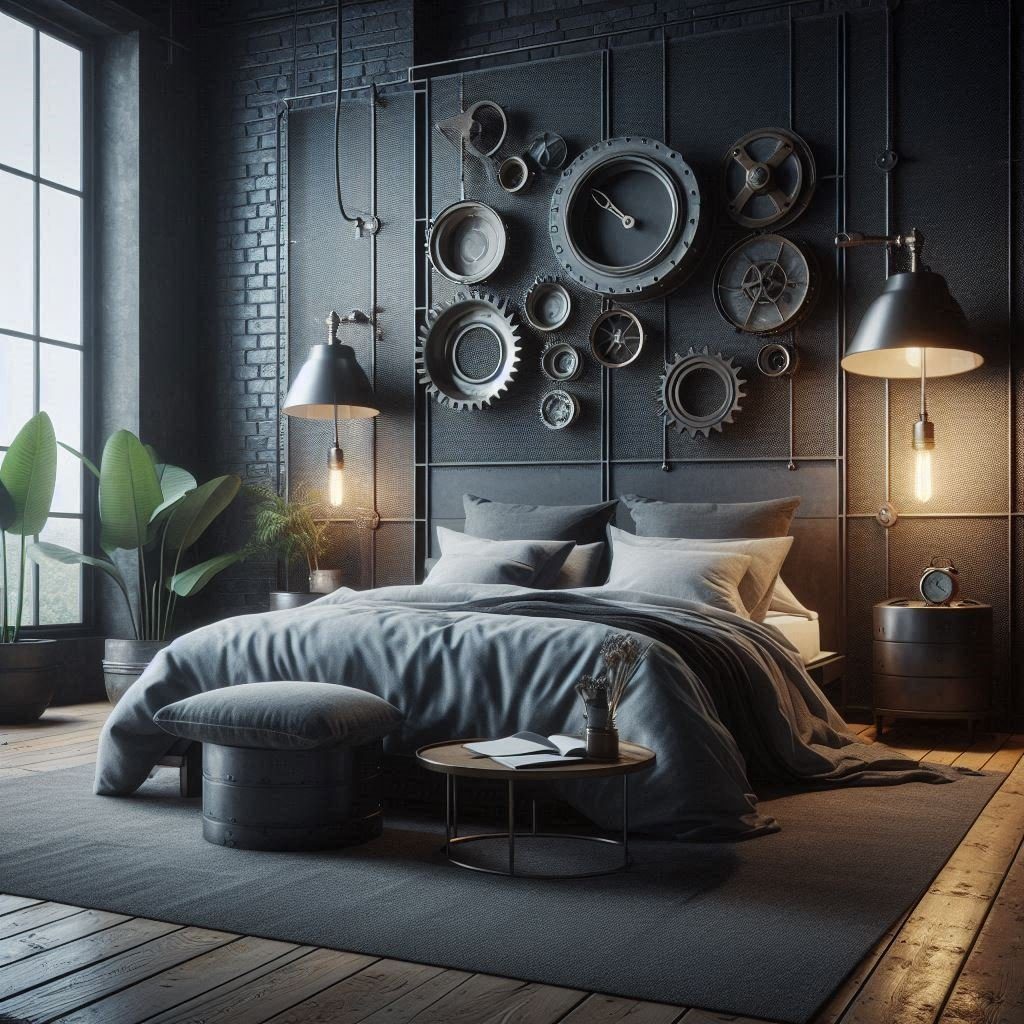
The strategic use of mixed metals adds sophistication and visual interest to modern bedrooms. Combining finishes like brushed brass, matte black, and polished chrome creates a layered, luxurious look that elevates the overall design. This trend moves away from the traditional rule of matching all metal finishes, instead embracing a more eclectic and contemporary approach.
To successfully incorporate mixed metals, establish a dominant metal finish and use others as accents. Consider using metallic elements in light fixtures, drawer pulls, mirror frames, and decorative objects. The key is to distribute metal finishes evenly throughout the space to create a balanced, intentional look rather than a random collection of different metals.
10. Zone Lighting Design
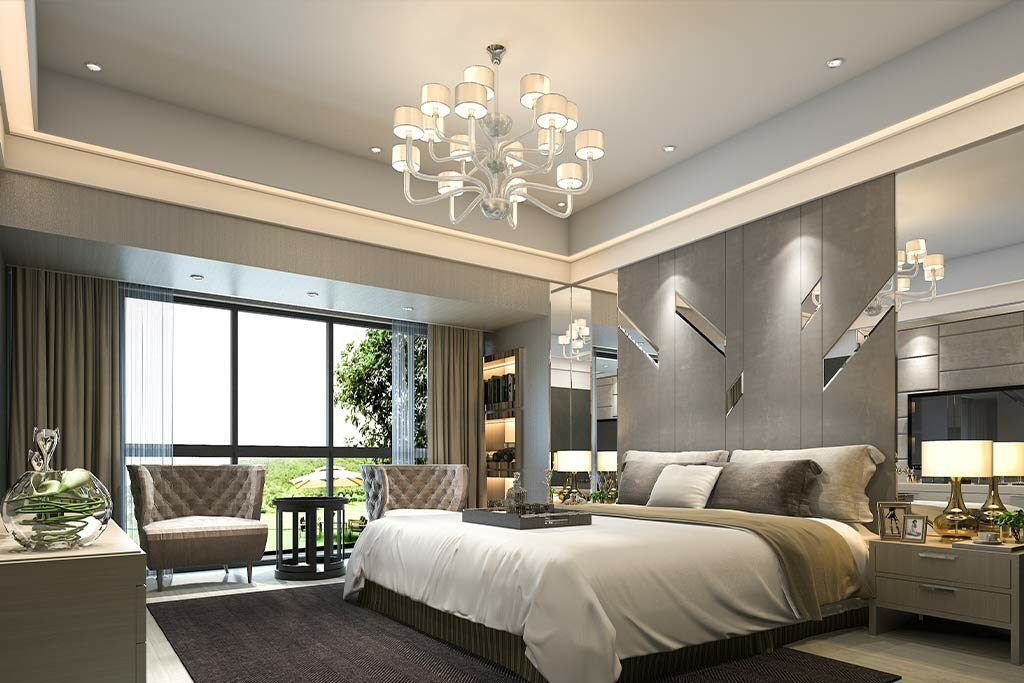
Modern bedroom lighting design emphasizes the creation of distinct zones through carefully planned illumination. This layered approach combines ambient, task, and accent lighting to enhance functionality and atmosphere. Smart lighting systems allow for preset scenes that can be activated for different activities or times of day.
Incorporating a variety of light sources at different heights creates visual interest and practical functionality. Consider recessed ceiling lights for general illumination, adjustable bedside sconces for reading, and LED strips for accent lighting. The ability to control different lighting zones independently allows for maximum flexibility in creating the desired ambiance for any occasion.
11. Artistic Headboard Designs
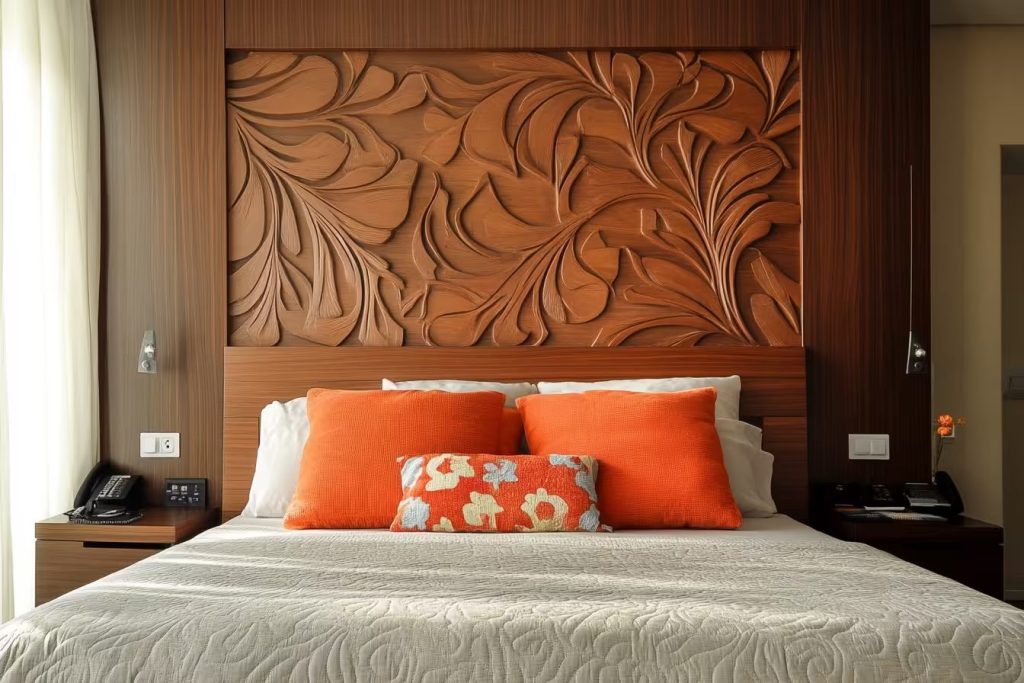
Modern headboards have evolved beyond traditional upholstered panels to become striking artistic statements. Custom-designed headboards featuring innovative materials, unusual shapes, or integrated lighting create dramatic focal points while maintaining functionality. These pieces often extend beyond the width of the bed or reach up to the ceiling, creating an architectural element that defines the entire space.
The selection of materials for modern headboards ranges from sleek metals and backlit panels to textured fabrics and geometric wood compositions. Consider incorporating built-in nightstands or shelving into the headboard design for a seamless, integrated look. The headboard can also serve as a natural division between sleeping and dressing areas in larger bedrooms.
12. Minimalist Window Treatments
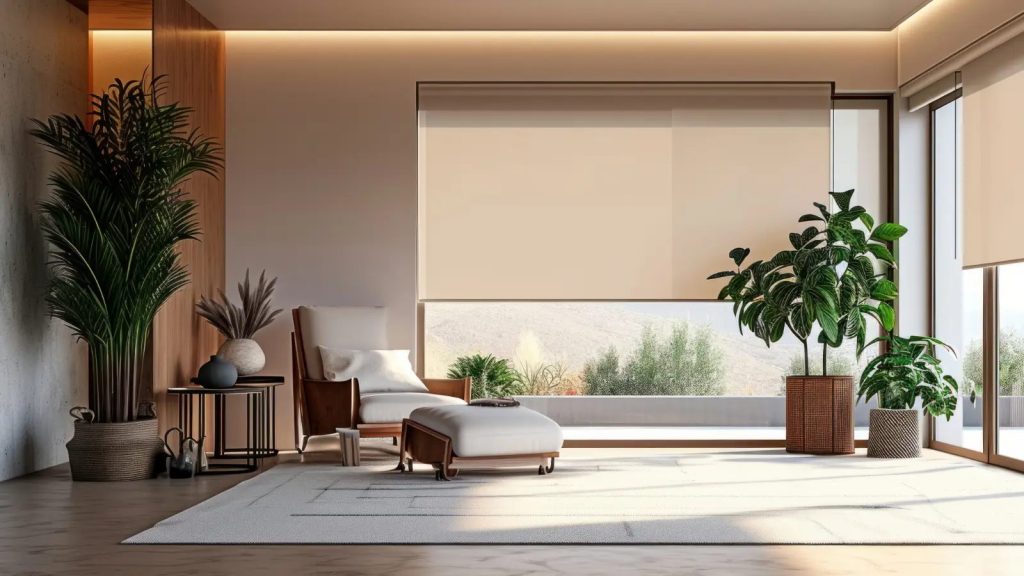
Contemporary window treatments emphasize clean lines and functional simplicity while maintaining privacy and light control. Motorized roller blinds, sleek panel systems, and automated shading solutions offer modern alternatives to traditional curtains. These minimalist options can be concealed within ceiling pockets when not in use, maintaining the room’s clean aesthetic.
The selection of materials for window treatments should complement the room’s overall design while providing necessary light control and privacy. Consider double-layered systems that combine sheer and blackout options, or smart glass technology that can switch from transparent to opaque at the touch of a button. The key is to choose solutions that enhance both the room’s functionality and its modern aesthetic.
13. Tech-Integrated Furnishings
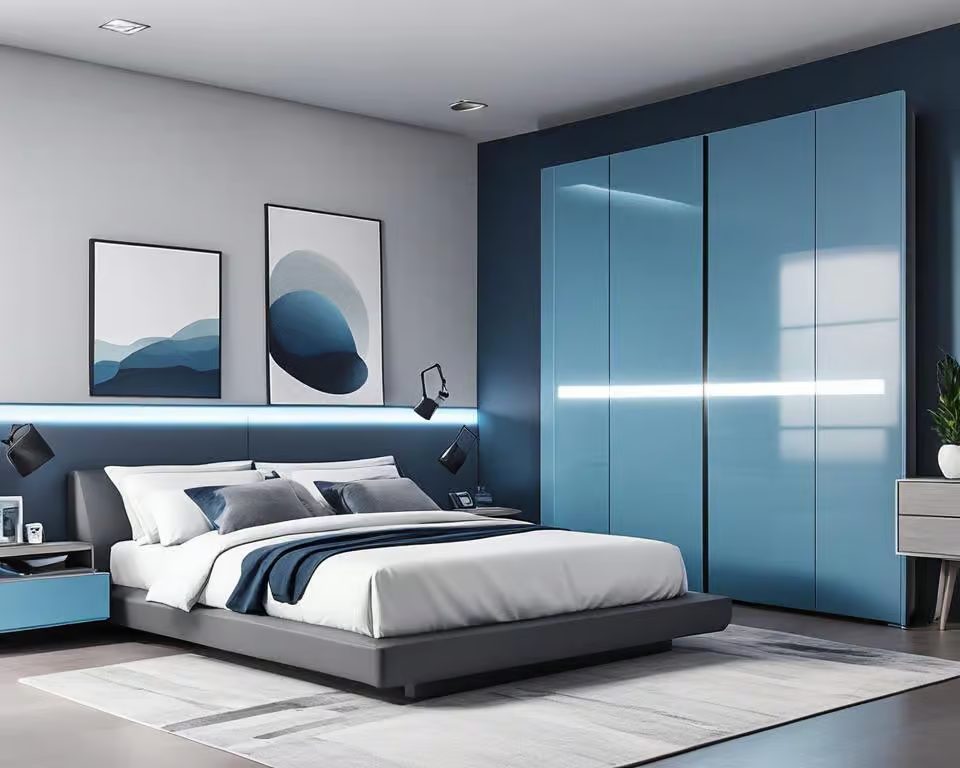
Modern bedroom design increasingly incorporates technology-enabled furniture that enhances convenience and functionality. Beds with built-in USB charging ports, nightstands with wireless charging capabilities, and smart mirrors with integrated displays represent the fusion of technology and furniture design. These pieces maintain clean lines while providing practical solutions for our connected lifestyle.
When selecting tech-integrated furnishings, focus on pieces that offer genuine utility while maintaining aesthetic appeal. Consider furniture with hidden charging stations, built-in speakers, or automated storage systems. The goal is to incorporate technology seamlessly without compromising the room’s serene atmosphere or modern design principles.
14. Custom Built-Ins
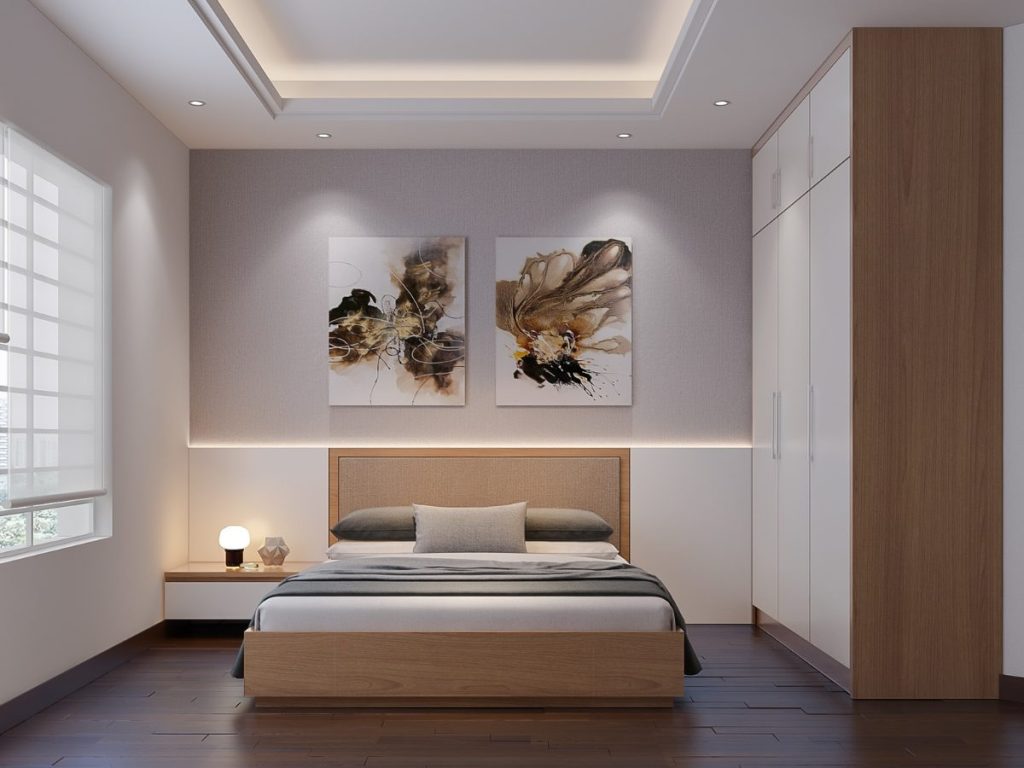
Built-in storage and display solutions offer a sophisticated approach to organizing modern bedrooms while maximizing space efficiency. Custom cabinets, window seats with storage, and integrated desk areas create a seamless look that can be perfectly tailored to your specific needs and room dimensions. These permanent fixtures become architectural elements that add value to the space.
The design of built-ins should complement the room’s modern aesthetic while providing practical storage solutions. Consider incorporating hidden lighting, touch-latch mechanisms, and modular components that can be reconfigured as needs change. The use of high-quality materials and precise craftsmanship ensures these custom elements enhance the room’s overall design while serving their functional purpose.
15. Abstract Art Integration
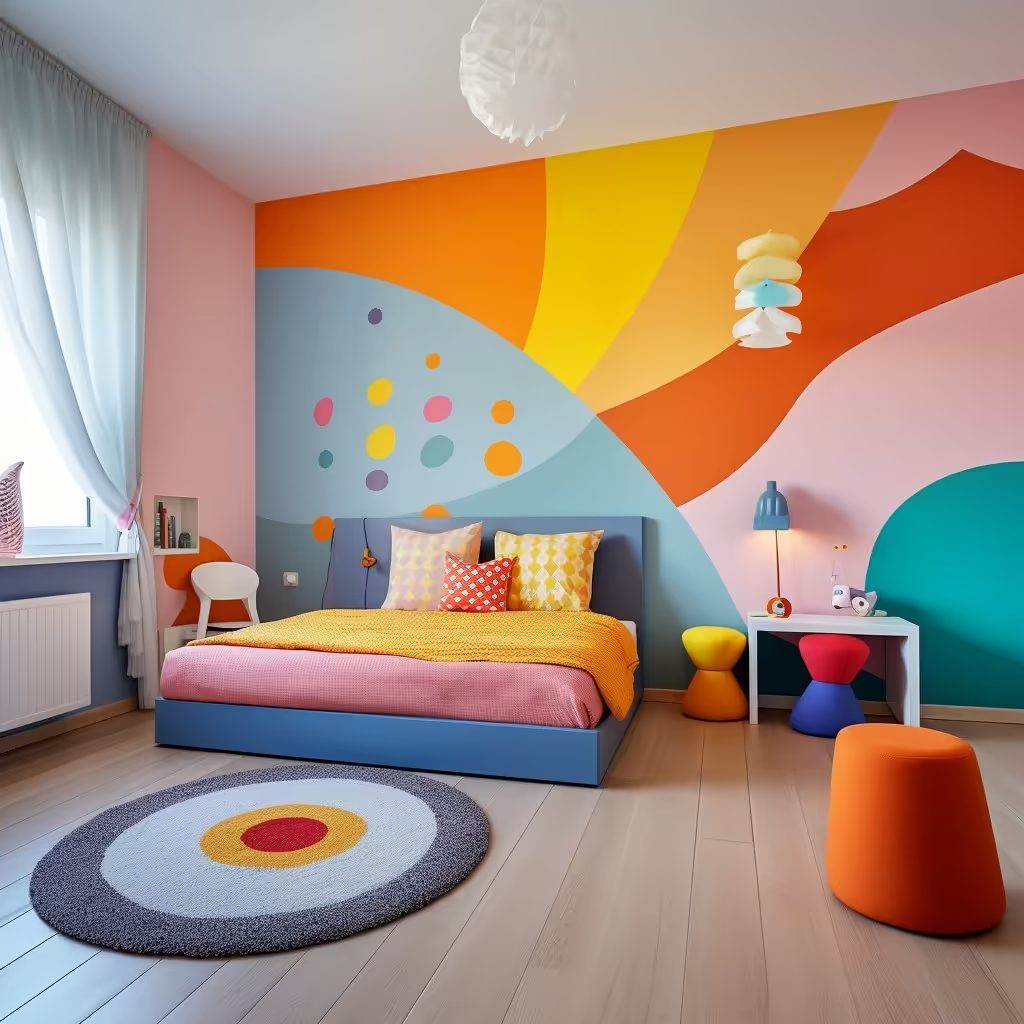
Large-scale abstract art pieces serve as powerful focal points in modern bedrooms, adding personality and visual interest while maintaining contemporary sophistication. These pieces can influence the room’s color palette and set the tone for the entire space. The key is selecting artwork that complements the room’s design while making a strong statement.
Consider how the artwork interacts with other elements in the room, including lighting, furniture placement, and color schemes. Abstract pieces can be used to add bold color to monochromatic spaces or to tie together various design elements. The scale of the artwork should be appropriate for the wall space, creating impact without overwhelming the room.
Related Guide: 14 Stunning Moody Bedroom Ideas
16. Multifunctional Spaces
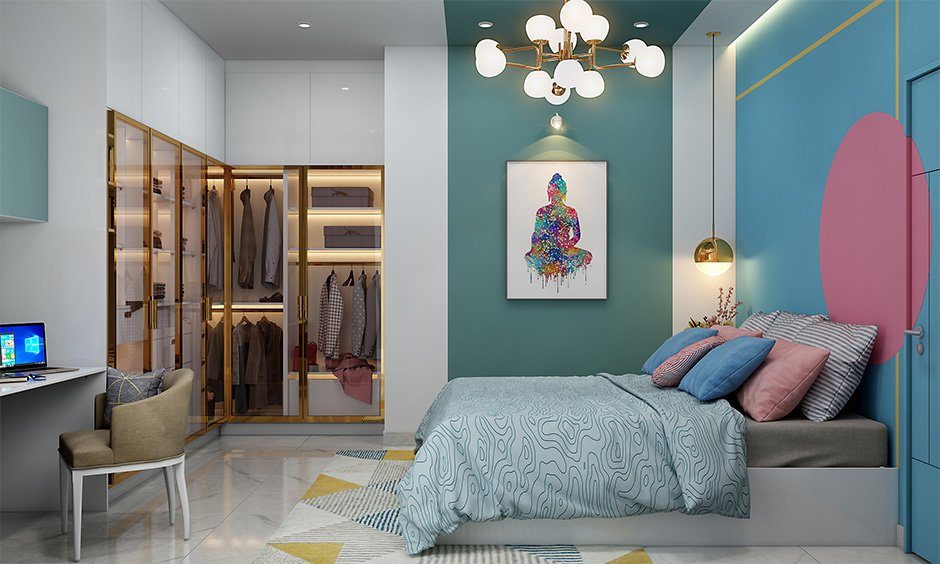
Modern bedroom design often incorporates flexible spaces that can serve multiple purposes. Home office nooks, meditation corners, or small seating areas create versatile environments that adapt to different needs throughout the day. The key is designing these areas to maintain visual harmony with the room’s primary function as a sleep space.
Careful space planning and the selection of appropriate furniture pieces ensure these multifunctional areas enhance rather than detract from the bedroom’s serene atmosphere. Consider using room dividers, sliding panels, or strategic furniture placement to define different zones while maintaining visual flow.
17. Natural Light Optimization
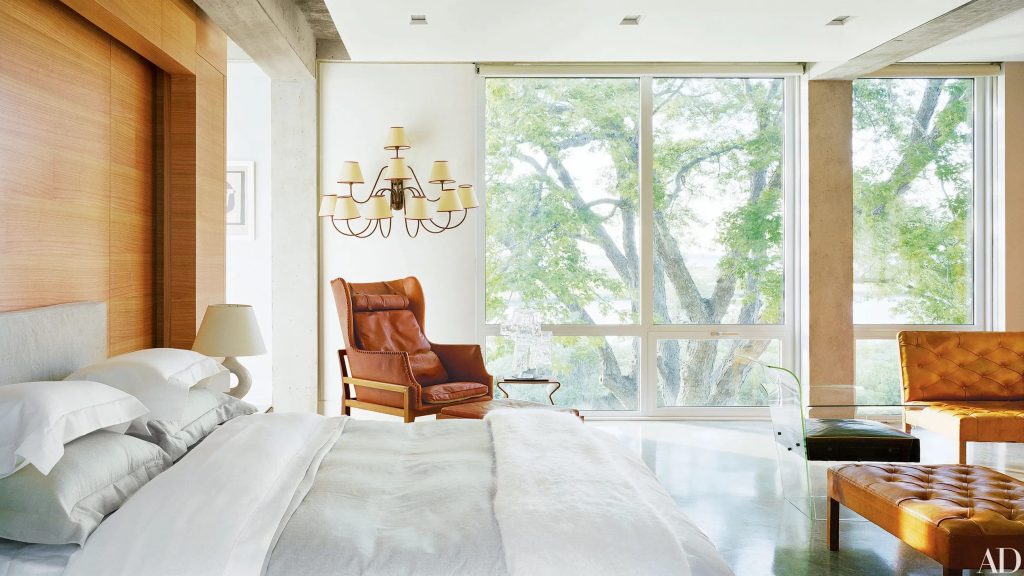
Maximizing natural light is crucial in modern bedroom design, contributing to both aesthetic appeal and well-being. Large windows, skylights, and glass doors not only flood spaces with natural light but also create connections with outdoor environments. Strategic window placement and the use of reflective surfaces can help distribute light throughout the room.
Consider how window treatments can be used to control light levels while maintaining privacy. The placement of mirrors and reflective surfaces should be carefully planned to bounce light into darker corners without creating glare. The goal is to create a bright, welcoming space that can still be darkened for optimal sleep conditions.
18. Sustainable Materials
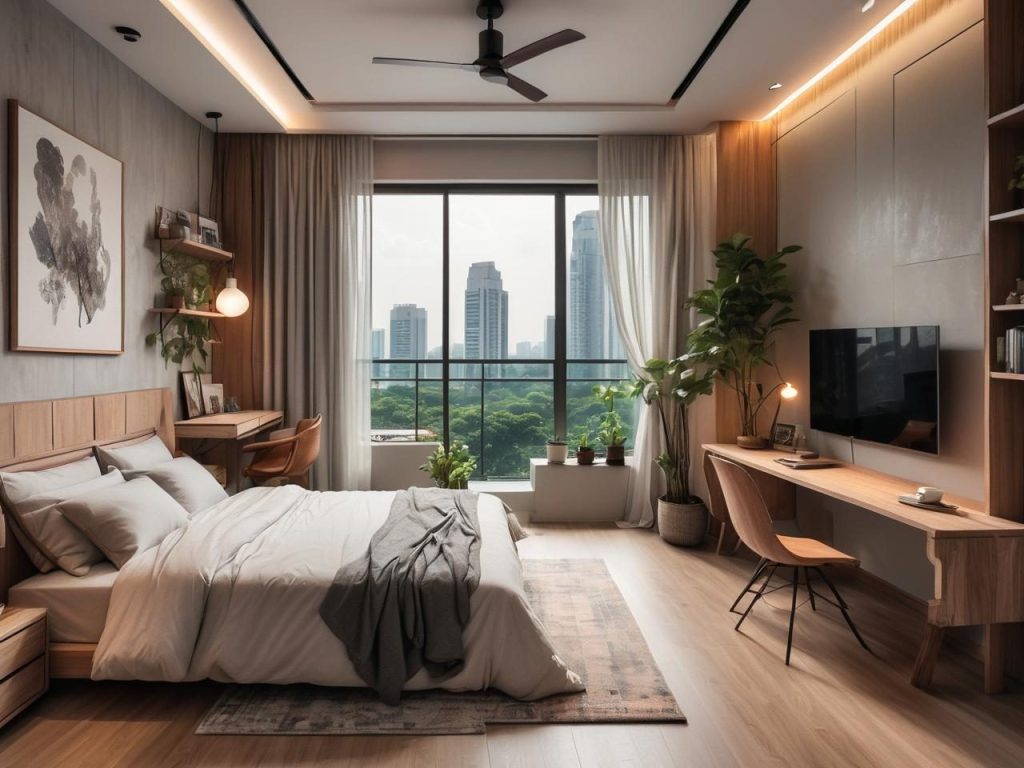
Modern bedroom design increasingly emphasizes sustainability through the use of eco-friendly materials and finishes. From bamboo flooring and recycled glass countertops to organic bedding and low-VOC paints, sustainable choices can create beautiful, healthy spaces while minimizing environmental impact.
The selection of sustainable materials should balance environmental consciousness with aesthetic appeal and durability. Consider using reclaimed wood, natural fibers, and materials with high recycled content. These choices can add unique character to the space while supporting environmental responsibility.
Conclusion
The modern bedroom has evolved into a sophisticated fusion of style, technology, and comfort, where every element serves both an aesthetic and functional purpose.
These 18 ideas demonstrate how contemporary design principles can be adapted to create personalized spaces that promote rest and rejuvenation while maintaining visual appeal.
By thoughtfully incorporating elements like smart storage solutions, biophilic design, and innovative lighting, you can transform your bedroom into a modern sanctuary that meets both your practical needs and design aspirations.
Remember that successful modern design is about finding the right balance between minimalism and personality, creating a space that feels both contemporary and deeply personal.

